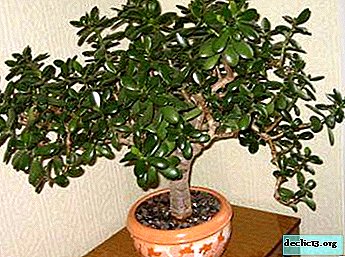The cactus began to rot. Why does this happen, what if the process goes from below?
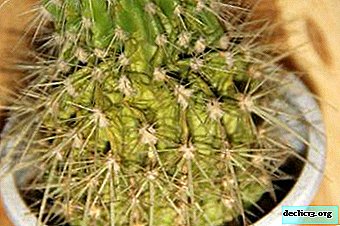
Cactus is considered one of the least whimsical house plants, however, with improper care and it is susceptible to various diseases. To find out that the "green hedgehog" is sick, you can not immediately. You should carefully monitor the condition of the prickly plant and take the necessary measures at the slightest deviation from the norm. One of the common diseases of cacti is rotting. About why this happens, what to do if the cactus has rotted from below, and how to save a rotting flower, we will tell in the article.
The defeat of the flower from the inside
Rotting inside is the most severe form of damage. In time to determine that the cactus is rotting from the inside is not always possible. Most often, such plants die (you can find out about what can cause a cactus to die and how to understand that a plant is dying, but from this article you will learn how to save a plant).
Signs
On the body of the plant, small, slowly increasing spots are found, light or dark, depending on the type of disease (what diseases and pests can destroy the plant?). At the same time, internal damage is significantly superior to those that are visible on the outer surface. When pressing on the affected area, softening of the body is felt.
Why is this happening?
The main reasons why cacti rot on the inside can be as follows.
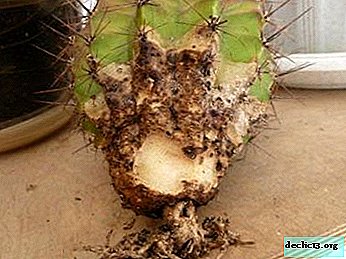 Dry rot (phomosis). This disease is of fungal nature. The causative agent is the fungus Phoma rostrupin. Most dangerous because it is difficult to detect. Dry, light, slightly indented spots resembling crusts appear on the plant. The spots themselves are covered with cracks. After pressing, the crust falls into a cavity in which all internal tissues are turned into a dry mess.
Dry rot (phomosis). This disease is of fungal nature. The causative agent is the fungus Phoma rostrupin. Most dangerous because it is difficult to detect. Dry, light, slightly indented spots resembling crusts appear on the plant. The spots themselves are covered with cracks. After pressing, the crust falls into a cavity in which all internal tissues are turned into a dry mess.- Brown rot. The causative agent is pathogenic bacteria from the genus Erwinia. There are foci of dark brown or brown, primarily between the edges of the cactus. The plant trunk softens, darkens.
- Rhizoctonia. It arises as a result of infection with pathogenic fungi of the genus Rhizoctonia. Mostly affected crops. The pathogen along the feeding vessels spreads inside the body of the cactus, causing wet rot.
- Black rot (alternariosis). Called by Alternaria radicina fungi. On the body of the plant, moist and shiny spots of brown color are found. The disease progresses rapidly.
- High humidity in the room where the plant is contained. More often, an excess of moisture causes rotting of the roots and neck of the cactus, but can also lead to decay of the plant from the inside.
How to save?
When detecting areas of rotting on a plant, first of all, it is necessary to assess the depth of the lesions. For this, the cactus is removed from the substrate, carefully inspected and palpated.
- If the pathological foci are not large, they are cut to a healthy tissue. The resulting wounds are treated with sulfur, coal or brilliant green. The cactus is dried for several days and planted in fresh soil (sand is best).
- If the body of the cactus is very softened and rotting is spread around its perimeter, then only a healthy top is cut off and left. It is dried and rooted, or grafted onto another cactus (more on what to do if the cactus has become soft, read here).
Is it possible to save if he began to hurt from below, at the base?
As a result of improper care, the roots and base of the cactus are affected and rotting processes develop. This is the most common form of damage to this type of plant. Fortunately, there is a chance to save the diseased cactus.
How to detect?
You can detect damage to the roots and neck of the cactus by the following signs:
- the rim is brown or brown in the lower part of the plant, on the border with the ground;
- the cactus falls to the side, poorly held in the ground;
- in advanced cases, the plant falls due to severe damage to the root system.
Source of infection
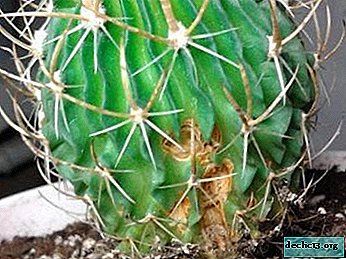 Cactus late blight (late blight, black root leg). Disease caused by fungi of the genus Phytophtora. The roots of the plant and the base of the stem are affected.
Cactus late blight (late blight, black root leg). Disease caused by fungi of the genus Phytophtora. The roots of the plant and the base of the stem are affected.- Helminthosporosis. Another disease of fungal etiology. The causative agent is Helminthosporium cactivorum. In the neck of the cactus, watery dark brown lesions are found. Mostly young plants are infected.
- Excessive watering. Cactus loves dry soils and with excessive moisture, the root system begins to rot very quickly.
- Improperly organized wintering. In the cold season, cacti need to arrange a dormant period during which a large amount of light and a minimum of moisture are provided to the plant. The temperature in the room with the plant should be + 12 ... 15 ° C.
In the event of any deviations from the required conditions, the cactus is susceptible to various diseases, including decay.
- Lack of moisture. Together with increased air temperature and intense lighting, insufficient watering can cause root decay.
What to do with a rotten plant?
The answer to the question of what to do if the root of the cactus has rotted, how to save the rotten flower, and whether it can be reanimated, in this case, is unequivocal. The plant is freed from the soil, the roots are thoroughly washed and the degree of damage is determined. All areas infected with rot are removed with a small margin, since fungal infections can spread to healthy tissues. Sections are treated with fungicides (sulfur, copper sulfate). After pruning, the cactus is dried and planted in dry sand. Watering is carried out through a pan, rarely and in small quantities. In such conditions, the plant is kept to root.
Dry rot
Identifying this disease is quite difficult. Usually dry rot is detected when the cactus is in its "deathbed" stage.
What to look for during the inspection?
When infected with Phoma rostrupin mushrooms, the plant turns pale and begins to dry out. Most often, this proceeds unnoticed. Then, dry, cracked crusts appear on the body of the cactus, when pressed, the finger falls into the trunk. If the stalk is cut, the cactus is empty, dried inside.
Background to the disease
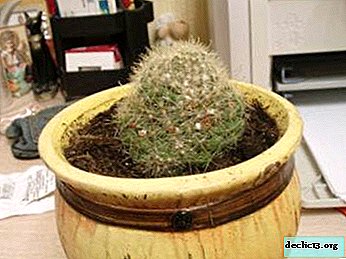 Skid pathogen phomosis through wounds on the trunk of a cactus. When transplanting, transporting a plant, you can accidentally violate the integrity of his body. In such cases, the fungus penetrates through the damaged areas, and the cactus is infected.
Skid pathogen phomosis through wounds on the trunk of a cactus. When transplanting, transporting a plant, you can accidentally violate the integrity of his body. In such cases, the fungus penetrates through the damaged areas, and the cactus is infected.- Violation of the conditions of wintering. With an improperly organized wintering, the resistance of the cactus to infectious diseases decreases.
- Excessive watering. Excess moisture causes rotting of the root system, which weakens the plant's resistance to infectious diseases.
- Vaccination sick cactus. Only healthy plants should be vaccinated.
- Transplanting into soil previously used for another plant. If a cactus sick with dry rot previously grew in the soil, such a substrate should be destroyed and in no case used for other plantings.
Is there anything you can do?
Effective methods to combat dry rot have not been developed. The disease develops quickly and ends with the death of a cactus. To prevent this disease, plants should be treated with fungicides on a quarterly basis, the conditions for keeping cacti and their wintering should be observed.
How to reanimate when a flower is completely affected?
It also happens that people go on vacation, having entrusted their "green hedgehog" to the care of a neighbor, and upon returning they find their pet in a terrible state, decayed to the very top.
What are the chances of rehabilitation?
If the majority of the plant has undergone decay processes, it is impossible to reanimate it; there simply is not enough strength to root such a cactus.In the case when the top has survived, you can try to root it. For this:
- the healthy part is cut and dried in an upright position for several days;
- the place of cut must be treated with charcoal or sulfur;
- then the surviving part is planted in dry soil with sparse watering until the roots appear.
How to care?
 Cactus is a plant that does not require special attention. Nevertheless, certain rules must be followed in order to avoid infection with its rot.
Cactus is a plant that does not require special attention. Nevertheless, certain rules must be followed in order to avoid infection with its rot.
- This plant requires a large amount of light, to place the cactus should be on the windowsill or near it.
- Water the cactus as necessary, adhering to the principle "the warmer the room, the more plentiful the watering", but not more than 1 time in 2 days.
- During the dormant period, the cactus is watered once every 1.5-2 weeks, and the temperature and lighting in the room are monitored.
Cactus care should be approached carefully and responsibly, although it does not require such great effort as for other indoor plants. With a competent approach, the cactus will delight its caring owners for decades.

 Dry rot (phomosis). This disease is of fungal nature. The causative agent is the fungus Phoma rostrupin. Most dangerous because it is difficult to detect. Dry, light, slightly indented spots resembling crusts appear on the plant. The spots themselves are covered with cracks. After pressing, the crust falls into a cavity in which all internal tissues are turned into a dry mess.
Dry rot (phomosis). This disease is of fungal nature. The causative agent is the fungus Phoma rostrupin. Most dangerous because it is difficult to detect. Dry, light, slightly indented spots resembling crusts appear on the plant. The spots themselves are covered with cracks. After pressing, the crust falls into a cavity in which all internal tissues are turned into a dry mess. Cactus late blight (late blight, black root leg). Disease caused by fungi of the genus Phytophtora. The roots of the plant and the base of the stem are affected.
Cactus late blight (late blight, black root leg). Disease caused by fungi of the genus Phytophtora. The roots of the plant and the base of the stem are affected. Skid pathogen phomosis through wounds on the trunk of a cactus. When transplanting, transporting a plant, you can accidentally violate the integrity of his body. In such cases, the fungus penetrates through the damaged areas, and the cactus is infected.
Skid pathogen phomosis through wounds on the trunk of a cactus. When transplanting, transporting a plant, you can accidentally violate the integrity of his body. In such cases, the fungus penetrates through the damaged areas, and the cactus is infected.


